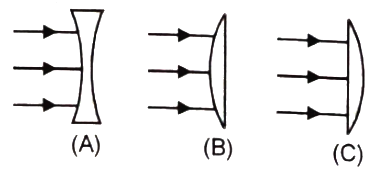Three lenses A, B and C are shown in the figure. Lens A is concave lens. B and C are plano-convex lenses. All the lenses have same focal length f. In which case the spherical; aberration is minimum?

1. A
2. B
3. C
4. All of the above

A small air bubble is present exactly at the centre of a glass sphere. Size of the image as seen from outside is of
(1) Same size
(2) Bigger
(3) Smaller
(4) May be smaller or bigger depending on the distance of observer
Three identical thin convex lenses are kept as shown in the figure. A ray passing through the lenses is shown. The focal length of each lens is

1. 5 cm
2. 10 cm
3. 15 cm
4. 20 cm
| 1. | smaller in size. |
| 2. | inverted. |
| 3. | between the focus and centre of curvature. |
| 4. | All of the above. |
| 1. | \(53^{\circ}\) | 2. | \(37^{\circ}\) |
| 3. | \(45^{\circ}\) | 4. | \(60^{\circ}\) |
In normal adjustment, the angular magnification of an astronomical telescope is 39. If the length of the tube is 2 m, then the focal length of the objective and eyepiece are respectively,
(1) 195 cm, 5 cm
(2) 190 cm, 10 cm
(3) 20 cm, 180 cm
(4) 10 cm, 190 cm
The following diagram shows a glass sphere of radius 10 cm with a paraxial incident ray. The refractive index of the material of the glass is

1. 2
2. 1.5
3. 1.75
4. 1.3
A convex lens of focal length 10 cm form real image of an object. The distance between the object and the image may be:
(1) 25 cm
(2) 30 cm
(3) 38 cm
(4) 50 cm
| 1. | \(45\) cm | 2. | \(30\) cm |
| 3. | \(15\) cm | 4. | \(25\) cm |
| 1. | \(X+Y\) | 2. | \(\dfrac{X +Y}{2}\) |
| 3. | \(X-Y\) | 4. | \(\dfrac{X -Y}{2}\) |






